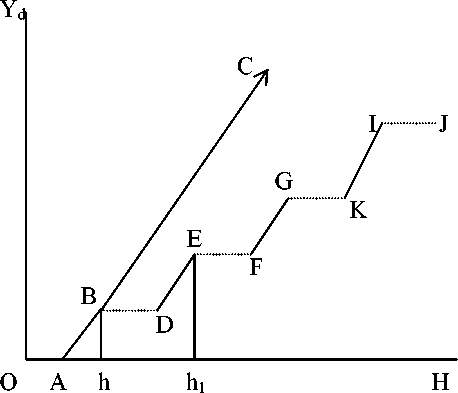COEFFICIENTS
|
Standardized |
t |
Sig. |
95% Confidence |
Correlations |
Collinearity | ||||
|
β |
Lower Bound |
Upper |
Zero-order |
Partial |
Tolerance |
VIF | |||
|
Constant |
-696.046 |
-.982 |
.328 |
-2099.02 |
706.930 | ||||
|
PHI |
0.822 |
15.769 |
.000 |
0.075 |
0.097 |
.825 |
.824 |
.994 |
1.006 |
|
EDN |
0.033 |
.640 |
.523 |
-959.697 |
1876.72 |
.095 |
.059 |
.994 |
1.006 |
a Dependent Variable: PHE
Source: Compiled from Primary Data
From the study it is found that as disposable
income (Yd) of the household increases,
individual takes more care of his life, hence
health expenditure (H) increases but at a
particular level of income, due to high life
risk, health expenditure becomes
independent of income and perfectly elastic,
which is termed as “High Life Risk Path
(HLRP)”. The health expenditure during
HLRP depends on household’s past saving
(S) and loanable capacity (L).
FIGURE 2
THE HEALTH EXPENDITURE CURVE

In figure 2, OA is autonomous health expenditure. In normal life, ABC is the health
expenditure curve (with linear relationship assumption between health expenditure and
disposable income) without any high life risk. But due to high life risk at Bh level of disposable
income, B is the bearable point3 and BD is the HLRP. Again normal life starts from point D to
point E. At Eh1 level of disposable income, E is the bearable point and EF is the HLRP and so
on. Hence, ABDEFGKIJ is the health expenditure path at high life risk, which is not a normal
path.
3 The bearable point is the point at which the maximum health expenditure can be financed from a particular level of
disposable income.
More intriguing information
1. TRADE NEGOTIATIONS AND THE FUTURE OF AMERICAN AGRICULTURE2. Searching Threshold Inflation for India
3. The name is absent
4. The name is absent
5. The name is absent
6. Stillbirth in a Tertiary Care Referral Hospital in North Bengal - A Review of Causes, Risk Factors and Prevention Strategies
7. Design and investigation of scalable multicast recursive protocols for wired and wireless ad hoc networks
8. AN ECONOMIC EVALUATION OF THE COLORADO RIVER BASIN SALINITY CONTROL PROGRAM
9. 5th and 8th grade pupils’ and teachers’ perceptions of the relationships between teaching methods, classroom ethos, and positive affective attitudes towards learning mathematics in Japan
10. Wirtschaftslage und Reformprozesse in Estland, Lettland, und Litauen: Bericht 2001